2022 HYUNDAI SANTA FE Display sp Ed
[x] Cancel search: Display sp EdPage 524 of 637
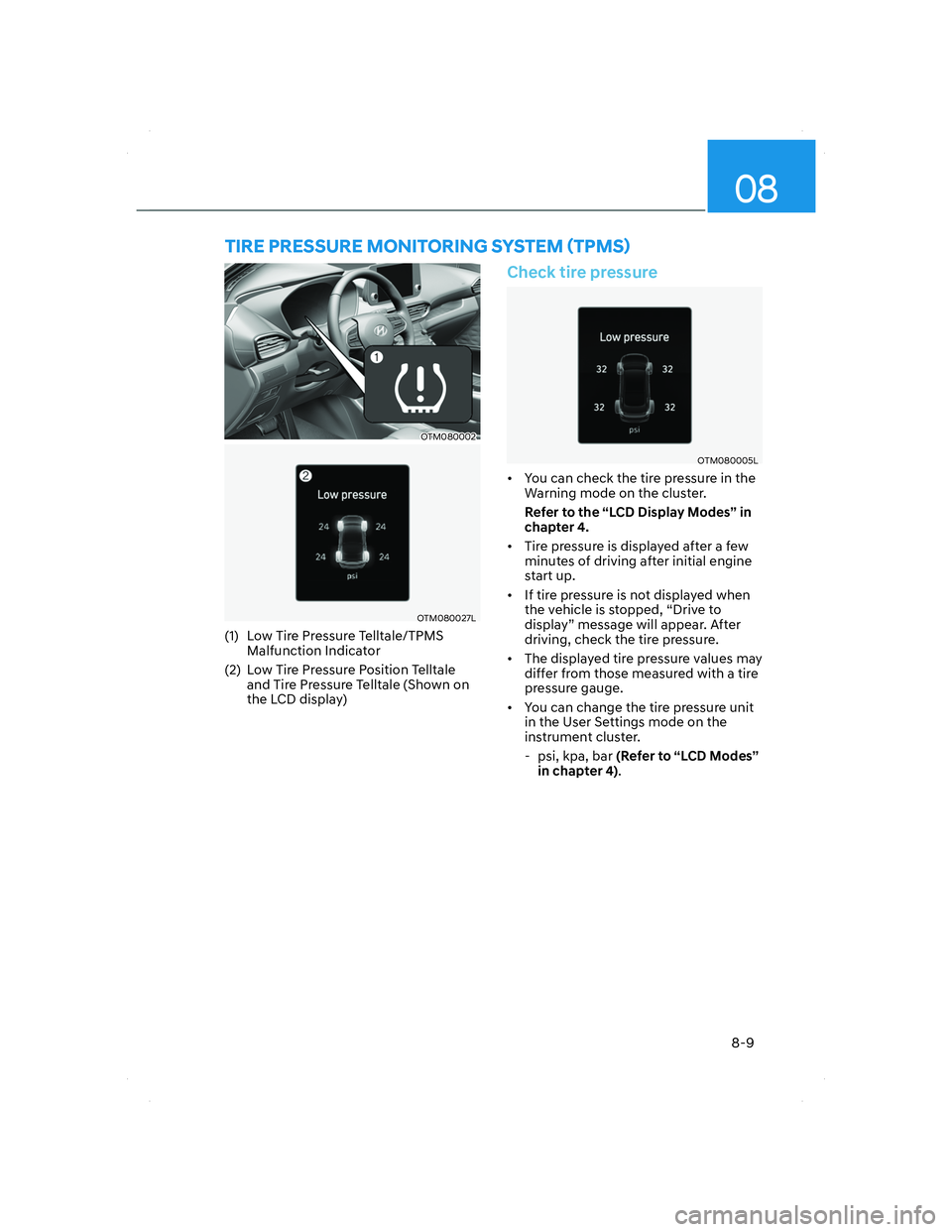
08
8-9
OTM080002OTM080002
OTM080027LOTM080027L
(1) Low Tire Pressure Telltale/TPMS
Malfunction Indicator
(2) Low Tire Pressure Position Telltale
and Tire Pressure Telltale (Shown on
the LCD display)
Check tire pressure
OTM080005LOTM080005L
• You can check the tire pressure in the
Warning mode on the cluster.
Refer to the “LCD Display Modes” in
chapter 4.
• Tire pressure is displayed after a few
minutes of driving after initial engine
start up.
• If tire pressure is not displayed when
the vehicle is stopped, “Drive to
display” message will appear. After
driving, check the tire pressure.
• The displayed tire pressure values may
differ from those measured with a tire
pressure gauge.
• You can change the tire pressure unit
in the User Settings mode on the
instrument cluster.
- psi, kpa, bar (Refer to “LCD Modes”
in chapter 4).
TIRE PRESSURE MONITORING SYSTEM (TPMS)
008_TMa_HMA.indd 8-92021-08-27 1:44:01
Page 526 of 637

08
8-11
Low tire pressure
warning light
Low tire pressure position and
tire pressure telltale
OTM080028LOTM080028L
When the tire pressure monitoring
system warning indicators are
illuminated and a warning message
displayed on the cluster LCD display,
one or more of your tires is significantly
under-inflated. The Low Tire Pressure
Position Telltale will indicate which
tire is significantly underinflated by
illuminating the corresponding position
light.
If either telltale illuminates, immediately
reduce your speed, avoid hard cornering
and anticipate increased stopping
distances. You should stop and check
your tires as soon as possible. Inflate the
tires to the proper pressure as indicated
on the vehicle’s placard or tire inflation
pressure label located on the driver’s
side center pillar outer panel.If you cannot reach a service station or
if the tire cannot hold the newly added
air, replace the low pressure tire with the
spare tire.
The Low Tire Pressure Telltale will remain
on and the TPMS Malfunction Indicator
may blink for one minute and then
remain illuminated (when the vehicle
is driven approximately 10 minutes at
speed above 15.5 mph (25 km/h)) until
you have the low pressure tire repaired
and replaced on the vehicle.
CAUTION
In winter or cold weather, the Low Tire
Pressure Telltale may be illuminated if
the tire pressure was adjusted to the
recommended tire inflation pressure
in warm weather. It does not mean
your TPMS is malfunctioning because
the decreased temperature leads to a
proportional lowering of tire pressure.
When you drive your vehicle from a
warm area to a cold area or from a cold
area to a warm area, or the outside
temperature is greatly higher or lower,
you should check the tire inflation
pressure and adjust the tires to the
recommended tire inflation pressure.
WARNING
Low pressure damage
Significantly low tire pressure makes
the vehicle unstable and can contribute
to loss of vehicle control and increased
braking distances.
Continued driving on low pressure tires
can cause the tires to overheat and fail.
008_TMa_HMA.indd 8-112021-08-27 1:44:03
Page 527 of 637
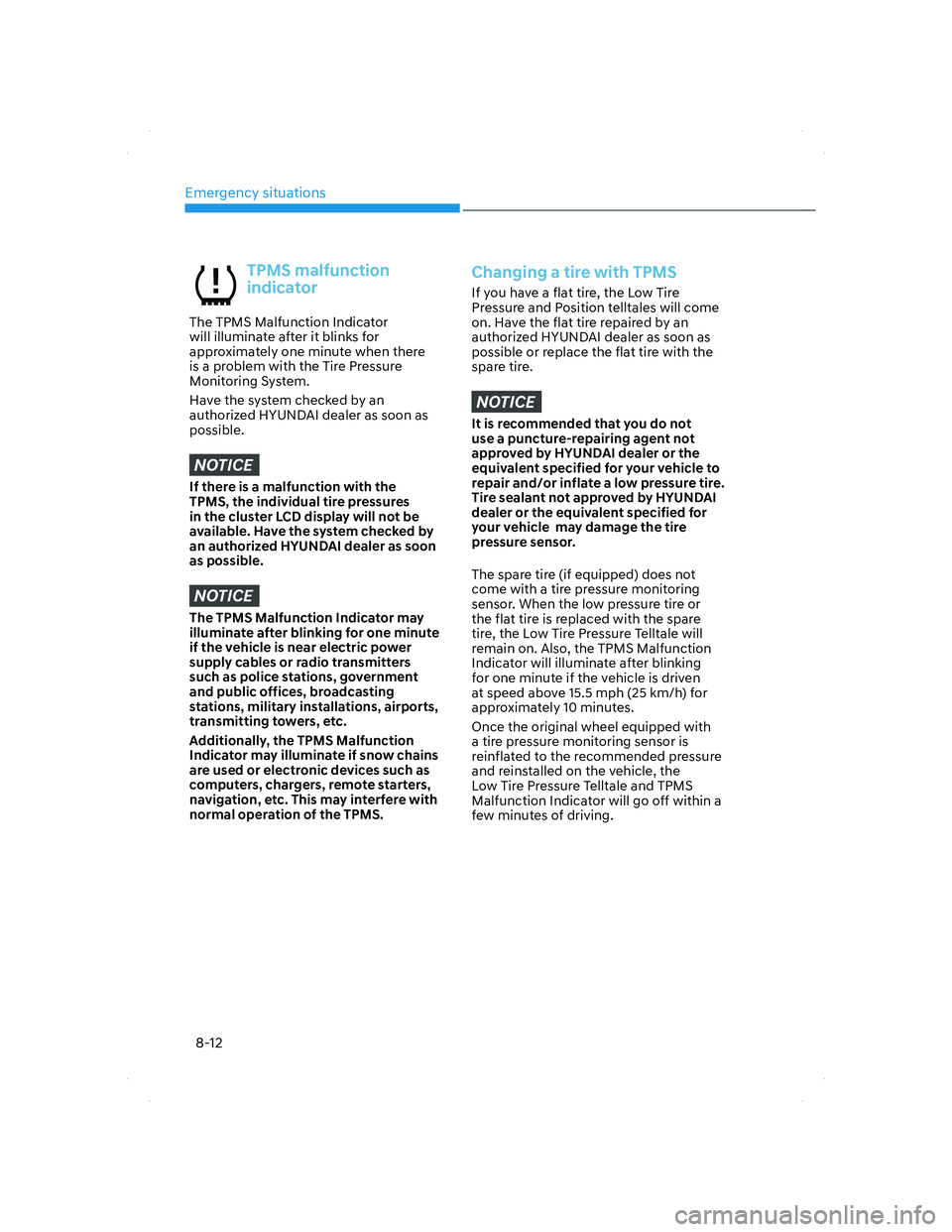
Emergency situations
8-12
TPMS malfunction
indicator
The TPMS Malfunction Indicator
will illuminate after it blinks for
approximately one minute when there
is a problem with the Tire Pressure
Monitoring System.
Have the system checked by an
authorized HYUNDAI dealer as soon as
possible.
NOTICE
If there is a malfunction with the
TPMS, the individual tire pressures
in the cluster LCD display will not be
available. Have the system checked by
an authorized HYUNDAI dealer as soon
as possible.
NOTICE
The TPMS Malfunction Indicator may
illuminate after blinking for one minute
if the vehicle is near electric power
supply cables or radio transmitters
such as police stations, government
and public offices, broadcasting
stations, military installations, airports,
transmitting towers, etc.
Additionally, the TPMS Malfunction
Indicator may illuminate if snow chains
are used or electronic devices such as
computers, chargers, remote starters,
navigation, etc. This may interfere with
normal operation of the TPMS.
Changing a tire with TPMS
If you have a flat tire, the Low Tire
Pressure and Position telltales will come
on. Have the flat tire repaired by an
authorized HYUNDAI dealer as soon as
possible or replace the flat tire with the
spare tire.
NOTICE
It is recommended that you do not
use a puncture-repairing agent not
approved by HYUNDAI dealer or the
equivalent specified for your vehicle to
repair and/or inflate a low pressure tire.
Tire sealant not approved by HYUNDAI
dealer or the equivalent specified for
your vehicle may damage the tire
pressure sensor.
The spare tire (if equipped) does not
come with a tire pressure monitoring
sensor. When the low pressure tire or
the flat tire is replaced with the spare
tire, the Low Tire Pressure Telltale will
remain on. Also, the TPMS Malfunction
Indicator will illuminate after blinking
for one minute if the vehicle is driven
at speed above 15.5 mph (25 km/h) for
approximately 10 minutes.
Once the original wheel equipped with
a tire pressure monitoring sensor is
reinflated to the recommended pressure
and reinstalled on the vehicle, the
Low Tire Pressure Telltale and TPMS
Malfunction Indicator will go off within a
few minutes of driving.
008_TMa_HMA.indd 8-122021-08-27 1:44:03
Page 539 of 637
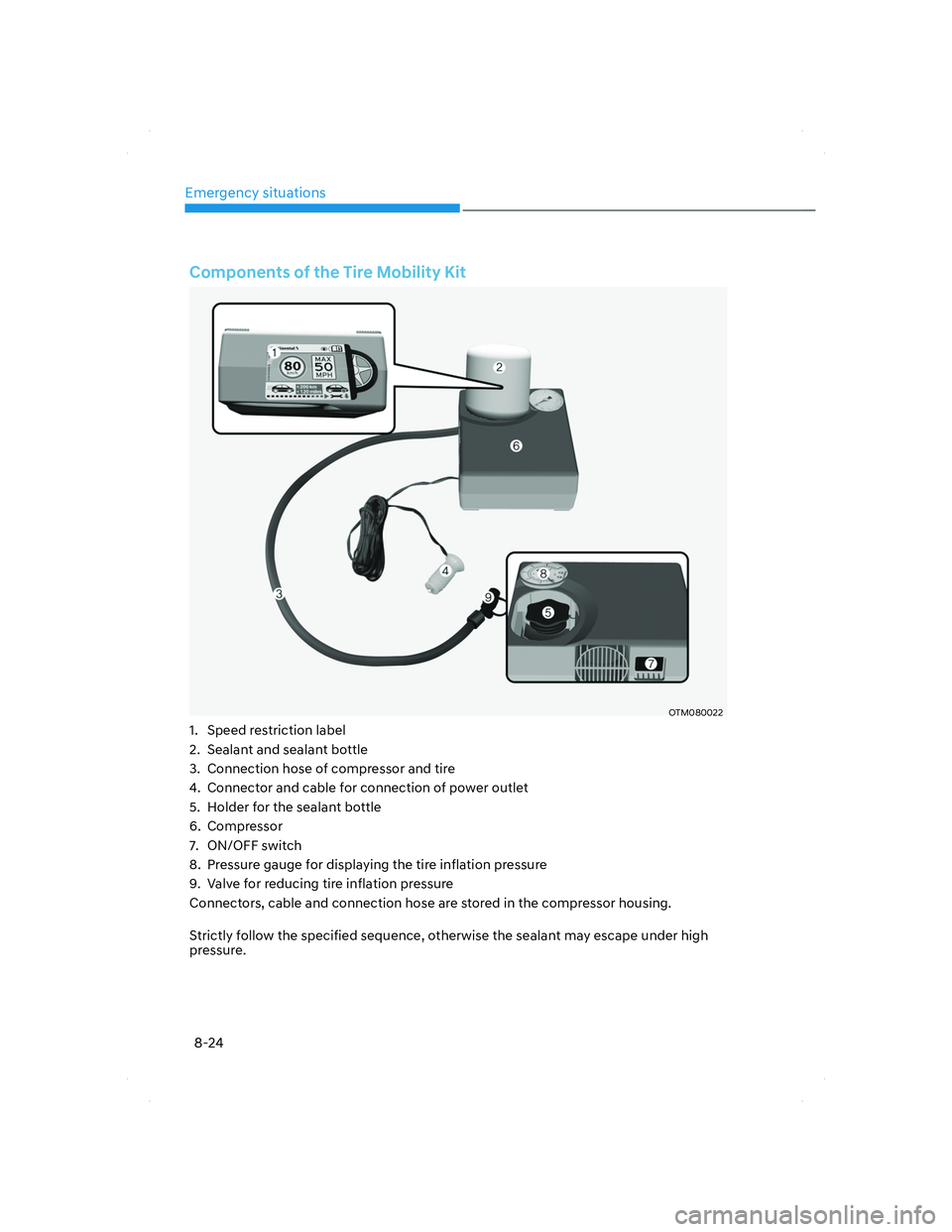
Emergency situations
8-24
Components of the Tire Mobility Kit
OTM080022OTM080022
1. Speed restriction label
2. Sealant and sealant bottle
3. Connection hose of compressor and tire
4. Connector and cable for connection of power outlet
5. Holder for the sealant bottle
6. Compressor
7. ON/OFF switch
8. Pressure gauge for displaying the tire inflation pressure
9. Valve for reducing tire inflation pressure
Connectors, cable and connection hose are stored in the compressor housing.
Strictly follow the specified sequence, otherwise the sealant may escape under high
pressure.
008_TMa_HMA.indd 8-242021-08-27 1:44:08
Page 584 of 637

09
9-39
Tire speed ratings
The chart below lists many of the
different speed ratings currently
being used for passenger vehicle
tires. The speed rating is part of the
tire size designation on the sidewall
of the tire. This symbol corresponds
to that tire’s designed maximum safe
operating speed.
Speed Rating
SymbolMaximum Speed
S 112 mph (180 km/h)
T 118 mph (190 km/h)
H 130 mph (210 km/h)
V 149 mph (240 km/h)
W 168 mph (270 km/h)
Y 186 mph (300 km/h)
3. Checking tire life (TIN : Tire
Identification Number)
Any tires that are over six years old,
based on the manufacturing date,
(including the spare tire) should be
replaced by new ones. You can find
the manufacturing date on the tire
sidewall (possibly on the inside of
the wheel), displaying the DOT Code.
The DOT Code is a series of numbers
on a tire consisting of numbers and
English letters. The manufacturing
date is designated by the last four
digits (characters) of the DOT code.
DOT : XXXX XXXX OOOO
The front part of the DOT shows a
plant code number, tire size and
tread pattern and the last four
numbers indicate week and year
manufactured.
For example:
DOT XXXX XXXX 1521 represents that
the tire was produced in the 15th
week of 2021.4. Tire ply composition and material
The number of layers or plies of
rubber-coated fabric in the tire. Tire
manufacturers also must indicate the
materials in the tire, which include
steel, nylon, polyester, and others.
The letter “R” means radial ply
construction; the letter “D“ means
diagonal or bias ply construction;
and the letter “B” means belted-bias
ply construction.
5. Maximum permissible inflation
pressure
This number is the greatest amount
of air pressure that should be put in
the tire. Do not exceed the maximum
permissible inflation pressure. Refer
to the Tire and Loading Information
label for recommended inflation
pressure.
6. Maximum load rating
This number indicates the maximum
load in kilograms and pounds that
can be carried by the tire. When
replacing the tires on the vehicle,
always use a tire that has the same
load rating as the factory installed
tire.
Page 596 of 637
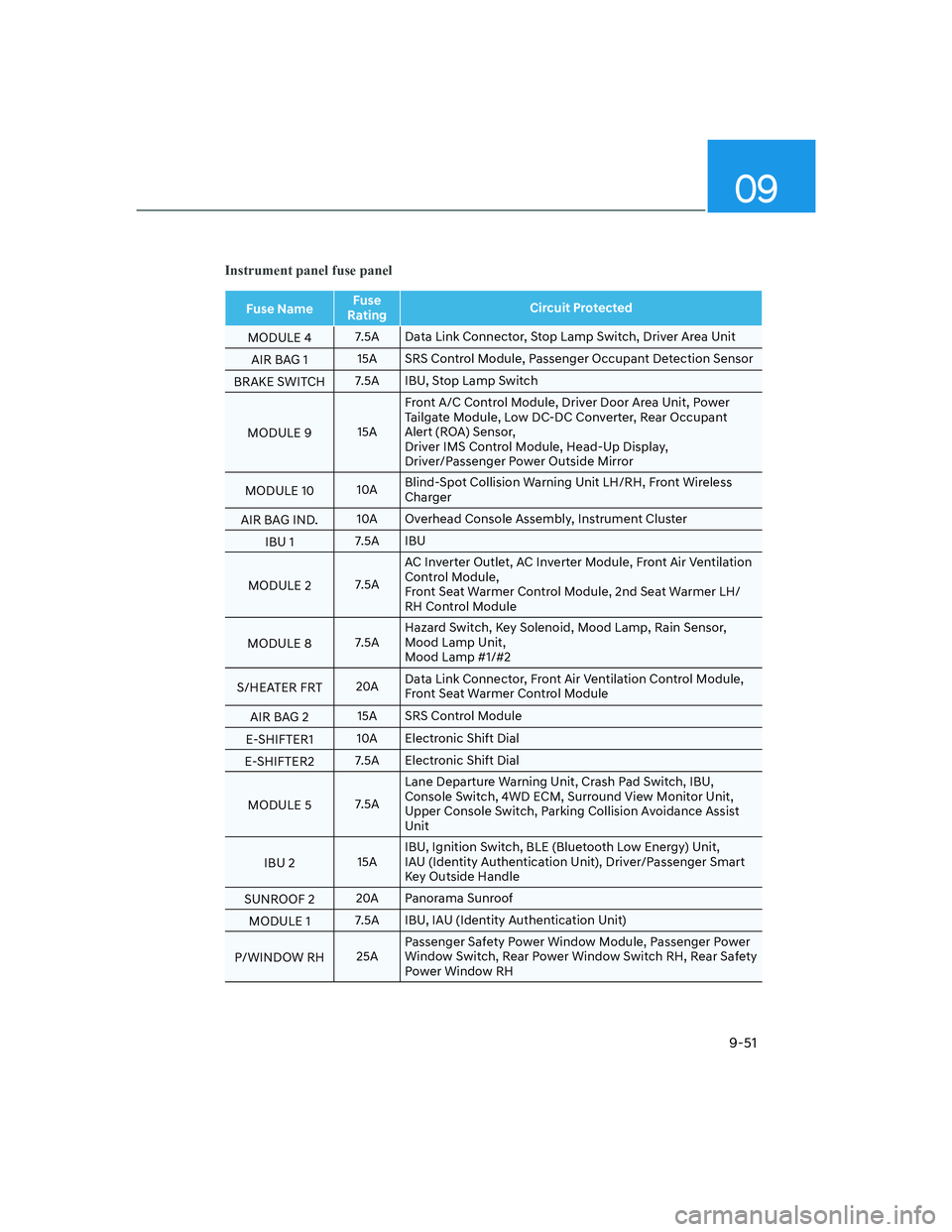
09
9-51
Instrument panel fuse panel
Fuse NameFuse
RatingCircuit Protected
MODULE 47.5A Data Link Connector, Stop Lamp Switch, Driver Area Unit
AIR BAG 115A SRS Control Module, Passenger Occupant Detection Sensor
BRAKE SWITCH7.5A IBU, Stop Lamp Switch
MODULE 915AFront A/C Control Module, Driver Door Area Unit, Power
Tailgate Module, Low DC-DC Converter, Rear Occupant
Alert (ROA) Sensor,
Driver IMS Control Module, Head-Up Display,
Driver/Passenger Power Outside Mirror
MODULE 1010ABlind-Spot Collision Warning Unit LH/RH, Front Wireless
Charger
AIR BAG IND.10A Overhead Console Assembly, Instrument Cluster
IBU 17.5A IBU
MODULE 27.5AAC Inverter Outlet, AC Inverter Module, Front Air Ventilation
Control Module,
Front Seat Warmer Control Module, 2nd Seat Warmer LH/
RH Control Module
MODULE 87.5AHazard Switch, Key Solenoid, Mood Lamp, Rain Sensor,
Mood Lamp Unit,
Mood Lamp #1/#2
S/HEATER FRT20AData Link Connector, Front Air Ventilation Control Module,
Front Seat Warmer Control Module
AIR BAG 215A SRS Control Module
E-SHIFTER110A Electronic Shift Dial
E-SHIFTER27.5A Electronic Shift Dial
MODULE 57.5ALane Departure Warning Unit, Crash Pad Switch, IBU,
Console Switch, 4WD ECM, Surround View Monitor Unit,
Upper Console Switch, Parking Collision Avoidance Assist
Unit
IBU 215AIBU, Ignition Switch, BLE (Bluetooth Low Energy) Unit,
IAU (Identity Authentication Unit), Driver/Passenger Smart
Key Outside Handle
SUNROOF 220A Panorama Sunroof
MODULE 17.5A IBU, IAU (Identity Authentication Unit)
P/WINDOW RH25APassenger Safety Power Window Module, Passenger Power
Window Switch, Rear Power Window Switch RH, Rear Safety
Power Window RH
Page 597 of 637

Maintenance
9-52
Instrument panel fuse panel
Fuse NameFuse
RatingCircuit Protected
ISG15ALow DC-DC Converter (AMP), Instrument Cluster, Front
A/C Control Module, A/V & Navigation Head Unit, Head Up
Display, Audio
RR SEAT(LH)25A2nd Seat Warmer LH Control Module, 2nd Seat LH Folding
Actuator
CLUSTER7.5A Instrument Cluster, Head Up Display
MDPS10AMDPS Unit
❈ MDPS(Motor Driven Power Steering) is the same as
EPS(Electric Power Steering).
A/C7.5A E/R Junction Block (Blower Relay, PTC Heater Relay)
CHILD LOCK15A ICM Relay Box (Child Lock/Unlock Relay)
DOOR LOCK20ADoor Lock Relay, Door Unlock Relay, Tailgate Relay, Driver
Door Unlock Relay
SUNROOF 120A Panorama Sunroof
P/WINDOW LH25ADriver Safety Power Window Module, Rear Power Window
Switch LH, Rear Safety Power Window LH
MODULE 37.5A IBU
MODULE 67.5AAudio, A/V & Navigation Head Unit, A/V & Navigation
Keyboard, Front A/C Control Module, Front Wireless
Charger, Electro Chromic Mirror, Low DC-DC Converter
WASHER15A Multifunction Switch
RR SEAT(RH)25A2nd Seat Warmer RH Control Module, 2nd Seat RH Folding
Actuator
WIPER RR15A Rear Wiper Relay, Rear Wiper Motor
AMP25A Low DC-DC Converter (With AMP)
ACC7.5AIBU, Front USB Charger, Low DC-DC Converter,
Rear USB Charger LH/RH, IAU (Identity Authentication
Unit)
P/SEAT (PASS)30A Passenger Seat Manual Switch
P/SEAT (DRV)30A Driver IMS Control Module, Driver Seat Manual Switch
Page 625 of 637
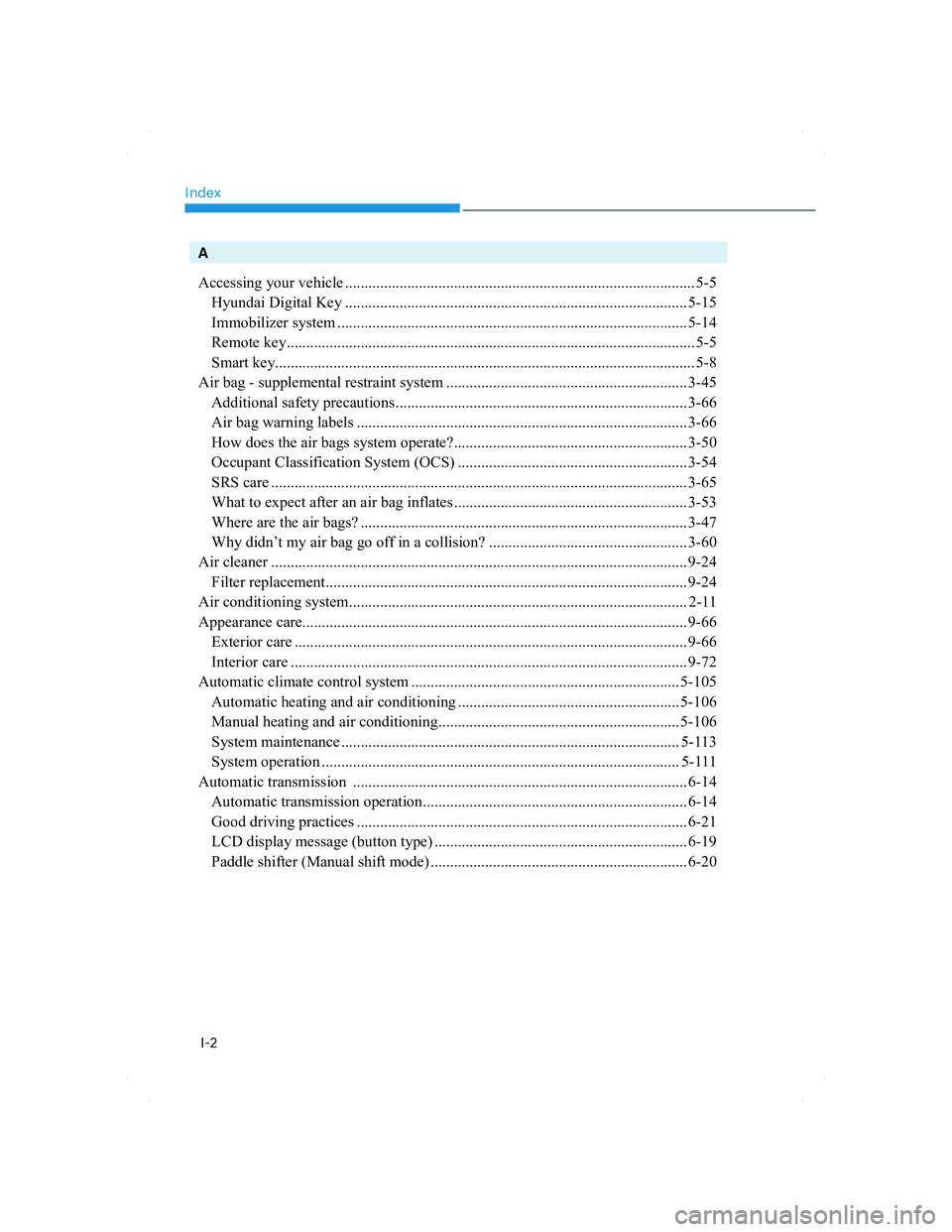
Index
I-2
A
Accessing your vehicle .......................................................................................... 5-5
Hyundai Digital Key ........................................................................................ 5-15
Immobilizer system .......................................................................................... 5-14
Remote key ......................................................................................................... 5-5
Smart key ............................................................................................................ 5-8
Air bag - supplemental restraint system .............................................................. 3-45
Additional safety precautions ........................................................................... 3-66
Air bag warning labels ..................................................................................... 3-66
How does the air bags system operate? ............................................................ 3-50
Occupant Classification System (OCS) ........................................................... 3-54
SRS care ........................................................................................................... 3-65
What to expect after an air bag inflates ............................................................ 3-53
Where are the air bags? .................................................................................... 3-47
Why didn’t my air bag go off in a collision? ................................................... 3-60
Air cleaner ........................................................................................................... 9-24
Filter replacement ............................................................................................. 9-24
Air conditioning system ....................................................................................... 2-11
Appearance care................................................................................................... 9-66
Exterior care ..................................................................................................... 9-66
Interior care ...................................................................................................... 9-72
Automatic climate control system ..................................................................... 5-105
Automatic heating and air conditioning ......................................................... 5-106
Manual heating and air conditioning .............................................................. 5-106
System maintenance ....................................................................................... 5-113
System operation ............................................................................................ 5-111
Automatic transmission ...................................................................................... 6-14
Automatic transmission operation .................................................................... 6-14
Good driving practices ..................................................................................... 6-21
LCD display message (button type) ................................................................. 6-19
Paddle shifter (Manual shift mode) .................................................................. 6-20
010_TMa_INDEX_HMA.indd I-22021-08-27 1:58:38